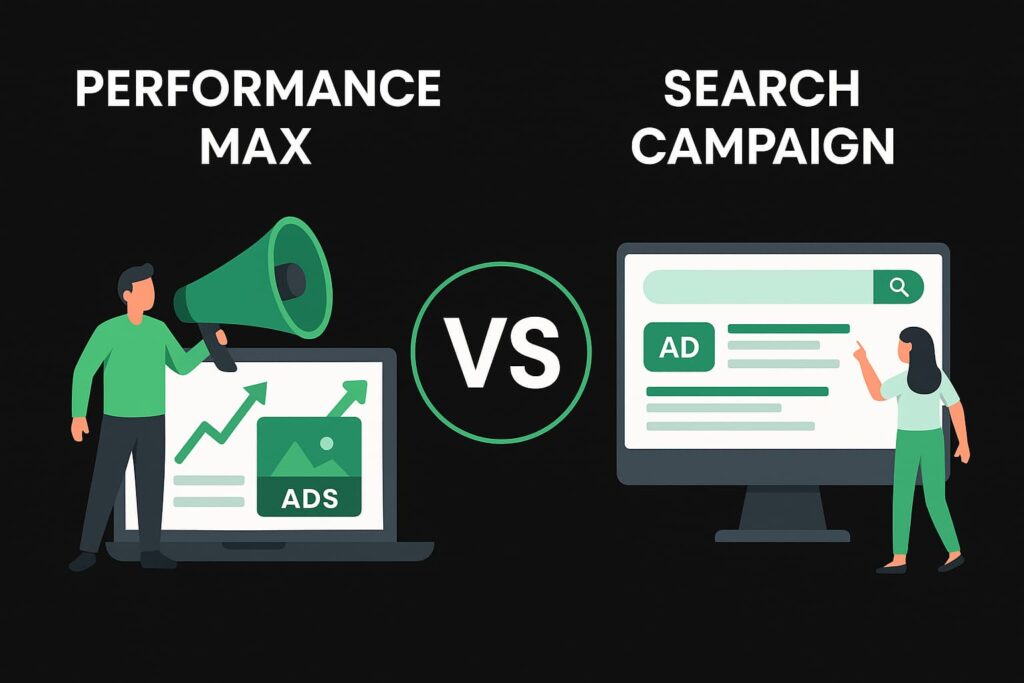Choosing between Performance Max vs Search Campaign can be one of the biggest strategic decisions for advertisers using Google Ads.
As Google continues to push automation, many marketers are wondering whether to embrace AI-driven campaigns or stay with the control of traditional search setups.
According to Google, advertisers who adopt Performance Max see an average 18% increase in conversions at a similar cost per action compared to standard Search campaigns. But automation isn’t always the best fit for every business.
Understanding how each campaign type works and when to use them helps you balance control, efficiency, and scalability for a stronger ROI.
What Is a Search Campaign?
A Search campaign is a campaign type within Google Ads that shows text-based ads when users actively search for keywords related to your product or service.
With Search campaigns, you manually select keywords, define match types, set bids, craft ad copy and specify audience or location targeting. The appeal lies in its high intent: you’re reaching users right when they’re searching for what you offer.
Pros:
- Strong intent-based targeting: your ad appears when someone is actively searching for your offering.
- Transparent data: you can see search terms, keyword performance, bid behavior, and make fine-tuned optimizations.
- Precise control: you decide the keywords, match types, ad copy, and bidding strategy.
Cons:
- Reach is limited to the Search Network (and optionally its partners); you’re not automatically covering Display, YouTube, or Discover.
- Requires ongoing manual effort: keyword management, bid adjustments, search term exclusions, and ad copy testing.
- Highly competitive keywords often lead to higher costs per click (CPC) and cost per acquisition (CPA).
What Is a Performance Max Campaign?
Performance Max (PMax) is a goal-based campaign type within Google Ads that enables advertisers to access all of Google’s ad inventory (including Search, Display, YouTube, Gmail, Discover, and Maps) from a single campaign.
PMax uses machine learning to optimize bids, asset combinations, placements, and audience signals automatically toward your conversion goals.
Pros:
- Broad reach: one campaign to access multiple channels rather than managing separate campaigns for each.
- Automation: machine learning handles bidding, placements and asset selection, potentially freeing up time and reducing complexity.
- Scalability: especially useful if you have robust conversion data and want to scale across networks.
Cons:
- Reduced transparency: you may not see detailed search terms or precise placement details (traditionally described as the “black-box” effect).
- Less control: fewer options for manual keyword targeting, placement exclusion and fine-tuned bidding per network.
- Requires strong setup: to take full advantage, you’ll need quality creative assets (images, video, headlines) and reliable conversion tracking/signals.
Core Differences Between Performance Max and Search Campaigns
Let’s dive into four major domains to compare these.
a) Targeting & Reach
With a Search campaign, you target users via keywords. They’ve expressed intent by searching a term relevant to your product or service. The reach is concentrated but highly focused.
By contrast, Performance Max expands reach well beyond search; your ads can appear on YouTube, Discover feeds, Gmail, Maps, Display sites, and Search. The targeting works via audience signals, asset combination,s and algorithmic placement rather than manual keyword lists.
b) Automation vs Manual Control
Search campaigns lean heavily on advertiser control: you pick keywords, set bids, exclude terms, write ad copy, and refine settings manually.
PMax shifts much of that control to automation. Google’s machine-learning algorithms decide asset combinations, placements, and bids internally to meet your target goals (for example: conversions, leads, or sales).
c) Reporting & Transparency
With Search campaigns, you get detailed reporting: search term reports, keyword performance, match-type breakdowns, and placement (when using search partners). This supports deep optimization and insights.
PMax historically offered less granularity. Reports may show campaign-level performance, but not always full breakdowns of channels or search terms. However, Google has recently improved reporting for PMax.
For example, the rollout of “Channel performance” reporting provides more insight into which channels (Search, YouTube, Display) are contributing.
d) Creative Assets & Ad Formats
In Search campaigns, your ads are primarily text-based: headlines, description lines, and ad extensions. You control the messaging tightly.
PMax uses a rich mix of creative assets: text, images, videos, headlines, and descriptions. The system dynamically combines these across channels to find the best-performing combinations.
| Feature | Search Campaign | Performance Max Campaign |
| Primary targeting | Keywords / intent-based | Audience signals + multi-channel |
| Reach | Search network only | Search + Display + YouTube + Discover etc. |
| Control | High manual control | High automation |
| Transparency | Detailed insights | More opaque / improving |
| Creative format | Text ads | Multi-asset (text/image/video) |
When to Use Performance Max vs Search Campaign
Choosing the right campaign type depends on your business situation, goals, and resources. Here are some practical guidelines.
Use Search Campaign When:
- You’re targeting high-intent keywords and want precise control over each keyword, match type, bid, and ad copy.
- Your goal is to test new offers, keywords, ad copy, or audiences, and you need detailed insights to optimize.
- Your budget is moderate, you’re focused on niche segments, or the reach across broader networks is less important for now.
Use Performance Max When:
- You have reliable conversion data (such as many past conversions) and strong creative assets (video, images, multiple headlines).
- Your goal is to scale across channels efficiently; you’re less concerned about individual keyword performance and more about total conversions or value.
- You want to simplify campaign structure: one campaign instead of separate Search, Display, and YouTube campaigns.
Hybrid/Combined Approach:
Often the best approach isn’t “either/or” but a thoughtful combination:
- Run a Search campaign for your core, high-intent keywords. This gives you control, transparency, and keyword-level insight.
- Add a Performance Max campaign alongside to expand reach across other Google networks and capture incremental conversions you might otherwise miss.
- Let automation handle scale, while you maintain manual control where it matters most (like budget allocation, messaging, and targeting).
This blended setup allows you to get the best of both worlds. Precision from Search and scalability from Performance Max.
Which Campaign Should You Choose?
There’s no one-size-fits-all answer; instead, think of it this way:
- If your priority is precision, keyword control, insight, and incremental testing, lean into a Search campaign.
- If your priority is scale, automation, multi-channel reach, and efficiency, lean into Performance Max.
- For most businesses, the optimal path is a tailored mix: run Search campaigns to cover your key intent keywords and maintain control, while deploying PMax to capture broader demand across Google’s full inventory and automated channels.
Be sure to monitor performance closely, especially in a PMax campaign. Keep an eye on asset performance, channel contributions (as more reporting becomes available), and conversion tracking health. Good creative + good data = better results.
Conclusion
Both Search campaigns and Performance Max campaigns have their place. A Search campaign offers depth, intent-based targeting, and fine-grained control. Performance Max offers breadth, automation, and opportunity to scale across Google’s ecosystem.
At Sierra Exclusive, we believe the most strategic approach is to treat them as complementary rather than competitive. Align your choice with your business goals, data maturity, creative capabilities, and budget.
If you’re uncertain which is right for you, or how to structure both in tandem, our PPC agency in Sacramento can help craft a high-performing hybrid strategy built around your growth goals.
Frequently Asked Questions
Can I run Performance Max and Search campaigns simultaneously?
Yes. Google designed Performance Max and Search campaigns to work together. Search covers exact-match keywords, while Performance Max expands reach across YouTube, Display, and other networks.
How does Google determine where to show Performance Max ads?
Google uses machine learning to decide ad placements based on your assets, goals, and audience signals. It automatically allocates your budget to channels most likely to drive conversions. Over time, it optimizes placements using performance data.
Are creative assets mandatory for Performance Max campaigns?
Yes. Performance Max needs images, headlines, and videos to create dynamic ads across all Google channels. Without a video, Google may generate one automatically from your assets.
Does Performance Max cannibalize Search campaign traffic?
Not typically. Search campaigns take priority when a keyword exactly matches a user’s query, while PMax fills in gaps elsewhere. Monitoring reports help ensure that both complement each other.
Which type of business is a better fit for Performance Max vs Search campaigns?
Performance Max suits brands that want a broad reach and automation. Search campaigns fit those who prefer precise keyword control and visibility. Many businesses use both for balanced results.




